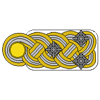A hardcover reference book with color and b&w photos by author David Doyle.
Link to Item
If you have comments or questions please post them here.
Thanks!
Armor/AFV
For discussions on tanks, artillery, jeeps, etc.
For discussions on tanks, artillery, jeeps, etc.
Hosted by Darren Baker, Mario Matijasic
REVIEW
251 Half-track by David DoylePosted: Tuesday, February 23, 2016 - 04:44 AM UTC
pstansell

Joined: November 10, 2005
KitMaker: 167 posts
Armorama: 163 posts

Posted: Wednesday, March 02, 2016 - 09:53 PM UTC
That's for that review Jim!
I feel that I should point out that we never "over enlarge" any photo that we use in any of our books. All images that go to print are within 10% of their physical size. In this particular book, almost all the images were culled from archival sources. Again, these images are obtained at a size greater that the intended use. Some of the images are taken from private sources, but these are scanned to a large size to fit our 10x8 format.
The biggest difference between archival images taken from the National Archives and those from the German Federal Archives is the size of the original negative. The U.S. Signal Corps in WWII used 2.25, 4x5 and sometimes even 8x10 format cameras for all of their work. German war photographers used almost exclusively 35mm. This smaller format is also somewhat less forgiving.
Like all cameras of the time, f-stop and shutter speed were selected manually. Depending on the conditions, this can result in a grainy image. We have to balance the historical value of an image versus its quality--not always an easy decision many cases.
Interestingly, the higher quality NARA images became the whole foundation of the Panzer Wrecks series. Even depicting the tanks knocked out, there was more detail in the photos due to the greater size of the negatives.
In this new series, we will continue to offer up what we hope to be rare and useful images to the enthusiast and modeler. Having personally reviewed and retouched every image, I am pretty excited about the stuff we uncovered!
Pat
MMiR
I feel that I should point out that we never "over enlarge" any photo that we use in any of our books. All images that go to print are within 10% of their physical size. In this particular book, almost all the images were culled from archival sources. Again, these images are obtained at a size greater that the intended use. Some of the images are taken from private sources, but these are scanned to a large size to fit our 10x8 format.
The biggest difference between archival images taken from the National Archives and those from the German Federal Archives is the size of the original negative. The U.S. Signal Corps in WWII used 2.25, 4x5 and sometimes even 8x10 format cameras for all of their work. German war photographers used almost exclusively 35mm. This smaller format is also somewhat less forgiving.
Like all cameras of the time, f-stop and shutter speed were selected manually. Depending on the conditions, this can result in a grainy image. We have to balance the historical value of an image versus its quality--not always an easy decision many cases.
Interestingly, the higher quality NARA images became the whole foundation of the Panzer Wrecks series. Even depicting the tanks knocked out, there was more detail in the photos due to the greater size of the negatives.
In this new series, we will continue to offer up what we hope to be rare and useful images to the enthusiast and modeler. Having personally reviewed and retouched every image, I am pretty excited about the stuff we uncovered!
Pat
MMiR
 |









